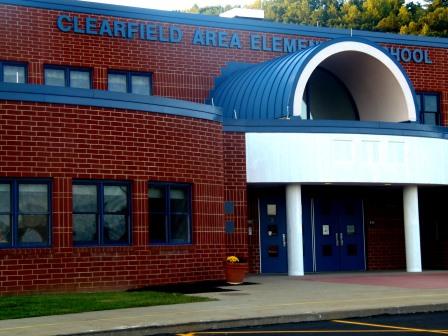CLEARFIELD – The Clearfield school board heard a presentation regarding recommended school facility improvements through a “Guaranteed Energy Savings Project” at Monday night’s regular meeting.
The project was presented by Jen Ponce de Leon and Brian Moore of the McClure Company. The board had previously asked the company to evaluate its district-wide energy performance and develop a summary of conservation measures.
The first energy conservation measure was lighting upgrades – gymnasium and exterior – at the Clearfield Area Elementary School.
It was recommended the district replace indoor lighting fixtures with high bay LED fixtures. Also, it was recommended to replace the existing building and parking lot exterior pole fixtures and wall packs with LED fixtures.
These lighting upgrades would increase lighting levels and uniformity, standardize equipment and result in energy and operational savings, according to Ponce de Leon.
The second energy conservation measure was building envelope – district-wide. Currently, there are building gaps, deteriorated and worn areas; penetration and expansion joint openings; and main entrance soffit overhang.
It’s been recommended that the district install new commercial grade sweeps and weather stripping on nine exterior doors.
It’s also been recommended that the district seal 2,790 feet of penetrations and expansion joints; construct an insulated wall for an air-tight, thermal barrier in the existing Clearfield Area Junior-Senior High School soffit; and seal 70 roof exhaust fans.
The third energy conservation measure was boiler room upgrades at CAES. Its existing gas-fired atmospheric boilers and water heater are nearing the end of their useful life, Moore said, and the boiler and piping arrangement are inefficient.
It was recommended that the district install two, gas-fired condensing hot water boilers and one gas-fired hot water heating system at CAES. Moore said this would improve the equipment efficiency, result in energy and operational savings and defer upcoming capital costs for repair.
The fourth energy conservation measure was an automation controls system upgrade at CAES. According to Moore, the existing pneumatic control system with valves and actuators are approaching 20 years old.
As a result, it was recommended that the district expand its existing Johnson Controls system to control the entire elementary building and not just the new addition. Moore said this would result in energy and operational savings and also defer future capital costs for replacement.
The fifth energy conservation measure was a data room cooling upgrade at the CAES. The school currently has four data rooms that are in need of proper, independent temperature control for IT equipment.
It was recommended that the district install an A/C system in each room in order to maintain interior, critical server environment with the appropriate temperature control. Moore said by doing so, it would extend the life of the IT equipment.
The sixth energy conservation measure was a guidance suite HVAC retrofit at the CAES. The suite is currently served by a four-pipe ducted blower coil unit.
It was recommended the district remove the suite from the central cooling to facilitate energy efficiency. It was also recommended that it provide independent off-hour and summer cooling by converting to a variable refrigerant flow (VRF) system.
The seventh energy conservation measure was a main office HVAC retrofit at the elementary school. Its main office equipment is approaching the end of its useful life, and is obsolete. It was recommended to install a new VRF system for better temperature control.
The eighth energy conservation measure was air handling unit replacements at the CAES. The school’s air handling units in the cafeteria, gymnasium and library are nearing the end of their useful life, according to Moore. For this, it was recommended that the district install new variable air volume air handling units with direct digital controls.
The ninth energy conservation measure was a chiller replacement and relocation at the CAES. The chiller is currently roof mounted and nearing the end of its useful life, as well as uses an obsolete refrigerant.
It was recommended to install a new variable speed, high efficiency packaged air-cooled chiller to be located at the old modular building.
Moore said this would result in energy and operational savings; defer future capital costs for replacement; make maintenance much easier; and free up space if the district would ever need to do a future, second-floor expansion.
The 10th energy conservation measure was a door replacement upgrade at the elementary school. The doors are aging, Moore said, and there’s deterioration with limited insulation value.
It was recommended that the district install 10, new sets of energy efficient doors, frames and glass that meet ASTM insulation values. Moore said it would improve fire and safety standards, in addition to deferring capital costs for replacement.
The final energy conservation measure was gymnasium cooling at the CAJSHS. Moore said there currently isn’t any cooling in the gymnasium areas, and it was recommended the district replace heating only air handling units (four) with new four-pipe heating and cooling air handling units to “improve comfort.”
If the district moved forward with all of the recommended energy conservation measures, the total project cost would be $2.774 million. If it moved forward with all, except for the CAJSHS gymnasium cooling, the total project cost would be $2.396 million, according to Ponce de Leon.
The 20-year energy and operational savings would be $836,364. “It wouldn’t include the high school gym cooling, but it would be like getting a $2.3 million project for $1.5 million,” she said.
When asked, Ponce de Leon said the district could select which energy conservation measures to move forward with and finalize any project plans by no later than February in order for it to begin this spring.




